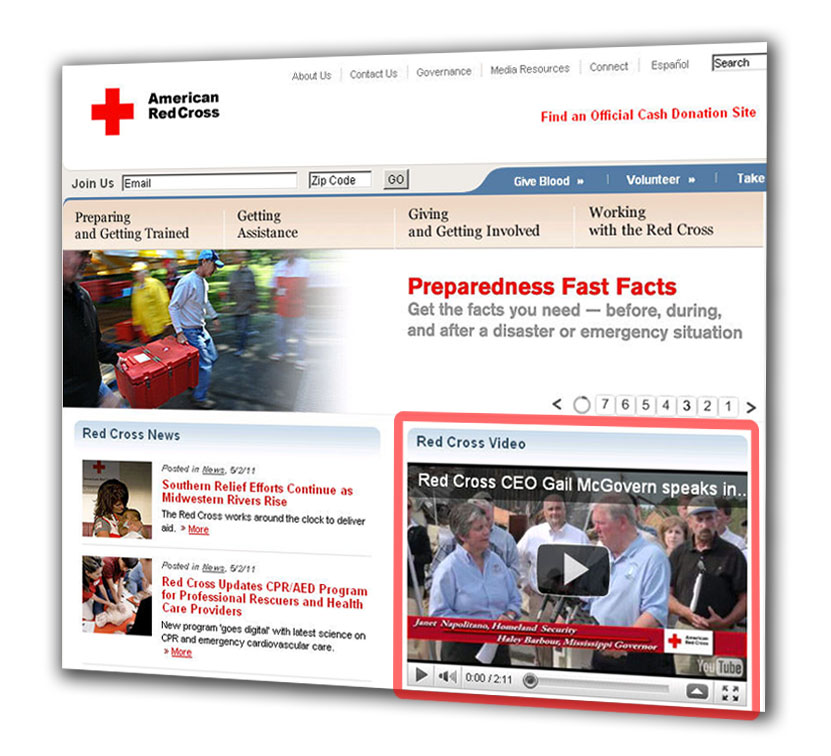
How should your non-profit share video online? There’s no shortage of options. Brightcove, YouTube, Vimeo, Kewego, SeeToo, Akami, and so on.
Most media websites, like the NYTimes or TV channels, have their own custom video players. This is so they can earn ad revenue, or exclusively show their content in the context of their website. As a NGO, your goals look different. Whether you’re advocating, informing or motivating, the point of your non-profit video is for people to see it, not to make ad revenue. Here’s 10 reasons why I think your org should go with YouTube.
1. Get the most views
Hosting and embedding on YouTube practically guarantee the highest amount of views. YouTube has the best sharing rate and best embedding rate (probably because people are already familiar to the user experience). Additionally:
- YouTube auto populates embeds links in twitter, Facebook, gmail, and heaps of other social sites.
- YouTube allows viewers to subscribe to your video uploads, and pushes them notifications.
- YouTube works on nearly all mobile phones, ipads, web browsers and other platforms.
Think back. When’s the last time someone sent you an email to check out a video that was buried in a site, and hosted on a 3rd party platform?
To be honest, the odds are already against your video “going viral”. If you don’t host via YouTube, your chances become almost laughable.
2. Technology
3d, 4k, HTML5, mobile-ready, social embedding… head spinning yet? You want to choose a video platform that is going to change as quickly as the web technology that delivers it. Brightcove is famously behind, Vimeo is quickly improving, but for implementing the latest technology, my money is on YouTube. And so is Google’s (Google purchased YouTube in 2004).
3. Search
YouTube is the second highest search engine. Not hosting your videos on YouTube is the SEO equivalent of not letting Google index your website. But it’s not just hosting. YouTube/Google give preference in search results to videos with higher view counts. In plain english: it’s not enough to just upload a copy of your video to YouTube and host via something else. You’ll want your video views to be “counted” for on YouTube, thus increasing your search result rankings, thus increasing your views via the worlds second highest search engine…. you get the picture.
4. Search (Part 2) or The United Airlines Effect
If you’re not the number one video result for your brand, someone else is. This is the number one result for United Airlines.
In the non-profit world, your top search result might be a homemade video from a donor. Chances are, it doesn’t pass branding control. Perhaps they’ve misinterpreted your message, or paternalised your recipients, or worse.
…It’s best for you to own your search results (or at least try).
5. In-video clickable giving
Interactive videos! As long as you’re a registered non-profit, you can add giving links, find our more links, and download our Annual Report links from within your videos. You can also link to other videos, like in these “choose your own adventure” style series. Brilliant!
6. Accessibility
To my knowledge, YouTube is the only video site actively pursing accessibility options. They’re working on auto-captioning, but until it’s perfect, CaptionTube syncs with YouTube to manually create subtitles. Plus, with such a large user base, many people are proactively adding their captions and translations. Online video has still has a way to go to establishing standards for accessibility–expect to see YouTube lead the way.
7. Community
The biggest difference between YouTube and other social video platforms (vimeo, metacafe) is the community. Like facebook and twitter, youtube has a community of users, celebrities and voices who are already popular. Recently, some NGO’s have begun tapping into these vloggers to spread the word about their work.
…If you’re an NGO not using YouTube, you probably won’t have much credibility with the “YouTubers”.
8. Video Quality
If you’re still under the impression that YouTube videos are all fuzzy and pixelated, you’re wrong. In 2009 YouTube announced support for full HD 1920×1080, blu-ray quality video. And in 2010, YouTube announced support for 4k resolution–best viewed on a 25 ft screen.
Think you’ll never need high resolution video? It’s an hour before your annual fundraising gala and you left the DVD at home… no problem if you have the video uploaded in high-def. Preload and stream it fullscreen… no need to tell the boss.
9. Downloads
For registered non-profits YouTube has added optional “download” functionality. For free. Burning and shipping DVD copies will soon (hopefully) become a thing of the past.
10. Faster International Uploading
When uploading videos from rural Tanzania, it’s important to have fast uploads and resumeable uploads (if you lose your connection for a moment, you don’t have to restart the entire process). Plus, YouTube processes video quicker than any other host I’ve worked with, including the expensive platforms.
…And it’s Free
You’re a non-profit. Hosting and serving up videos is expensive. I’ve yet to hear a compelling argument to spend thousands of dollars on what YouTube provides, better, and for free.
Agree? Disagree? Eager to hear your comments below.


